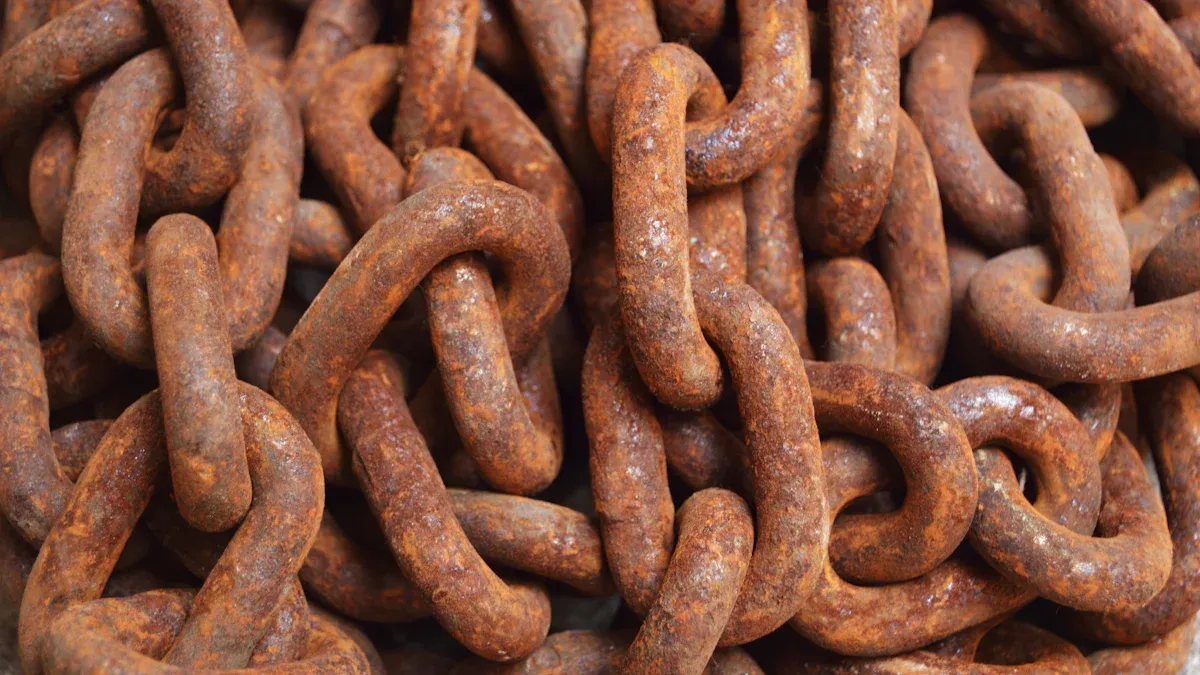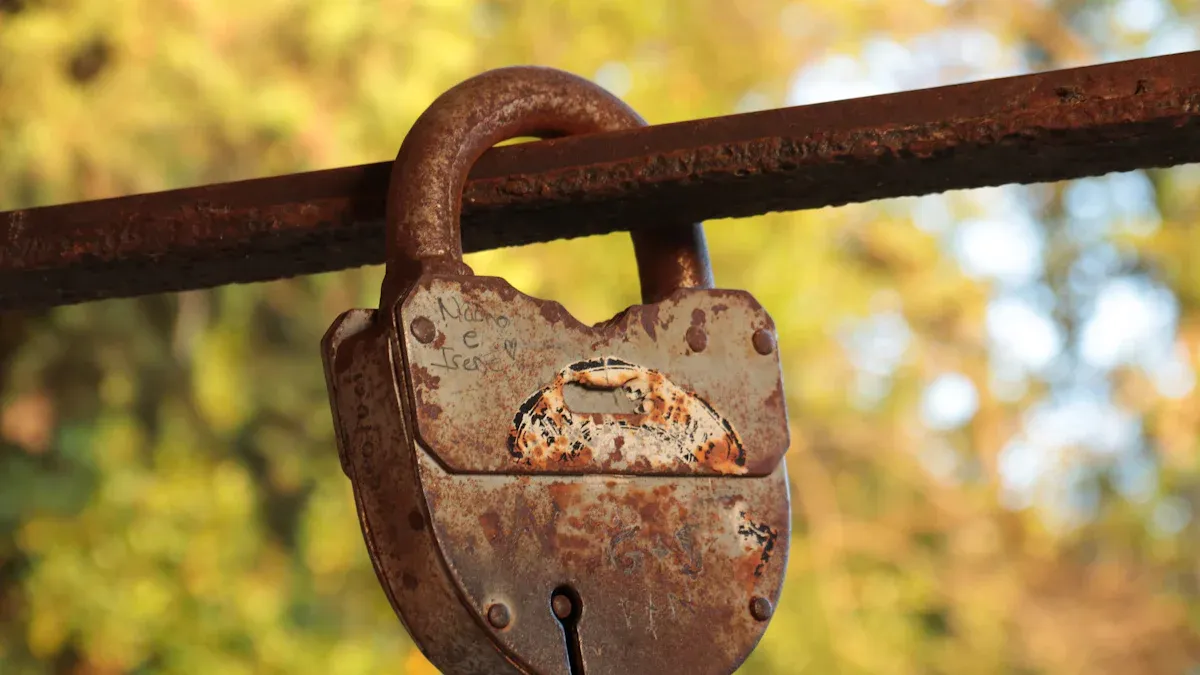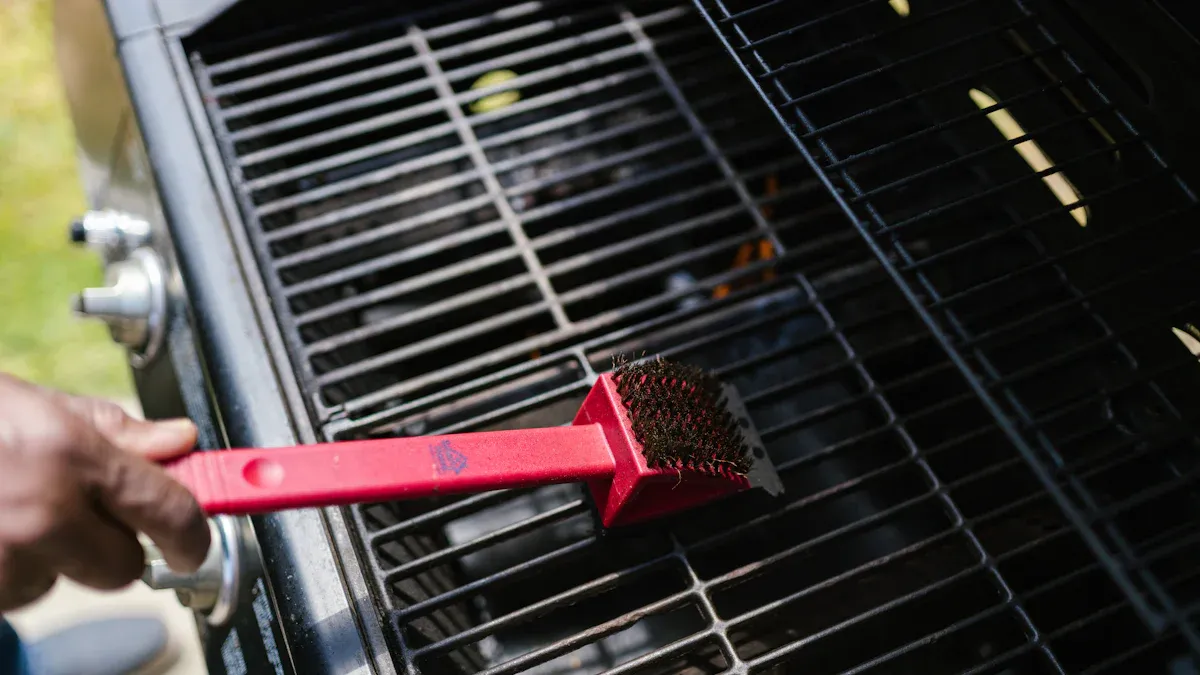
Preventing rust is crucial for maintaining the longevity and safety of display racks. Rust and corrosion can significantly diminish structural integrity and aesthetic appeal. Common causes of these issues include:
- Environmental Exposure: High humidity and poor climate control can lead to moisture accumulation.
- Material Composition: The type of steel used plays a vital role; standard steel is more susceptible to corrosion without proper finishes.
- Physical Damage: Scratches or dents from impacts can compromise protective coatings, exposing metal to corrosion.
The impact on display racks can be profound, resulting in increased replacement costs and diminished merchandise attractiveness.
Key Takeaways
- Prevent rust by controlling humidity levels. Use dehumidifiers to keep humidity below 35-40%.
- Choose corrosion-resistant materials like stainless steel or aluminum for display racks. These materials enhance durability and reduce maintenance needs.
- Apply protective coatings such as powder coating or galvanization. These coatings create a barrier against moisture and extend the life of display racks.
- Conduct regular inspections to catch early signs of rust. Look for rust marks, cracks, or pits during monthly checks.
- Implement a cleaning schedule. Clean display racks weekly to remove dust and moisture, and perform deep cleaning monthly.
- Store display racks in climate-controlled environments. Maintain stable temperatures to prevent corrosion from temperature fluctuations.
- Address rust immediately if found. Remove rust and apply a rust-inhibiting primer to prevent further damage.
- Consider the location of display racks. Outdoor racks need specialized finishes to withstand environmental exposure.
Understanding Rust and Corrosion

What is Rust?
Rust is a specific type of corrosion that primarily affects iron and its alloys. It forms when iron reacts with oxygen and water in a process known as oxidation. This chemical reaction can be summarized as follows:
- Iron + Oxygen + Water = Iron Oxide (Rust)
As the oxidation process continues, it gradually eats away at the metal, leading to visible rust formation. When iron atoms come into contact with oxygen molecules in the presence of moisture, they undergo this detrimental transformation.
What is Corrosion?
Corrosion encompasses a broader range of processes that lead to the deterioration of materials. It affects various substances, including metals, polymers, ceramics, and composites. Unlike rust, which specifically targets iron, corrosion can occur in many forms and involves complex electrochemical reactions.
| Aspect | Corrosion | Rust |
|---|---|---|
| Affected Materials | Affects various materials including metals, polymers, ceramics, and composites. | Specifically affects iron and its alloys. |
| Underlying Mechanism | A complex electrochemical process involving an anode, cathode, and electrolyte. | Result of corrosion, primarily in iron. |
| Process Complexity | More complex and irreversible, requiring a conductive electrolyte. | A simpler form of corrosion damage. |
Causes of Rust and Corrosion
Environmental Factors
Several environmental conditions contribute to rust and corrosion. Key factors include:
- Strong Chlorides: Environments rich in chlorides can lead to pitting corrosion, particularly in stainless steel grades like 304.
- Bimetallic Corrosion: Welding dissimilar metals can create galvanic corrosion, where the less noble metal corrodes faster.
- Contamination from Plain Iron or Steel: Residue from plain iron or steel can disrupt the protective oxide layer of stainless steel, leading to rust.
- Temperature Extremes: High temperatures can cause scaling and loss of the protective oxide layer, increasing corrosion risk.
- Unaccounted-for Environmental Factors: Coastal salt and moisture can lead to unexpected corrosion issues.
Material Composition
The material composition of display racks significantly influences their susceptibility to rust and corrosion. For instance, standard steel lacks the protective properties found in stainless steel or aluminum. Therefore, selecting the right materials is essential for preventing rust and ensuring the longevity of display racks.
By understanding the nature of rust and corrosion, individuals can take proactive steps to mitigate these issues, ultimately preserving the integrity and appearance of their display racks.
Effects on Display Racks
Structural Integrity
Rust and corrosion can severely compromise the structural integrity of display racks. As these processes progress, they lead to significant changes in the material properties of the racks. For instance, corrosion reduces the effective cross-section of structural components, which directly impacts their load-bearing capacity. This reduction can lead to catastrophic failures if the racks are overloaded or subjected to dynamic forces.
The following table summarizes the documented effects of corrosion on structural integrity:
| Effect of Corrosion | Description |
|---|---|
| Reduced Cross Section | Corrosion reduces the effective cross section of structural components, impacting their load-bearing capacity. |
| Reduced Ductility | Corroded sections exhibit lower ductility, which is critical for structures in seismic zones. |
| Fatigue Strength Reduction | Corrosion accelerates fatigue crack propagation, leading to reduced fatigue strength in steel elements. |
These changes can result in dangerous situations, especially in retail environments where display racks hold valuable merchandise. Regular inspections and maintenance practices are essential for preventing rust and ensuring that display racks remain safe and functional.
Aesthetic Appeal
In addition to structural concerns, rust and corrosion significantly affect the aesthetic appeal of display racks. Customers often judge products based on their presentation. A display rack that shows signs of rust can deter potential buyers and create a negative impression of the brand.
Rust stains and corrosion can lead to a perception of neglect, which can diminish customer trust. Retailers must prioritize the appearance of their display racks to maintain a positive shopping experience.
To combat these issues, businesses should consider implementing protective measures, such as selecting corrosion-resistant materials and applying protective coatings. These strategies not only enhance the visual appeal of display racks but also contribute to their longevity.
Selecting the Right Materials
Choosing the right materials for display racks is essential for preventing rust and ensuring longevity. Different materials offer unique advantages and disadvantages, impacting both performance and maintenance requirements.
Types of Materials for Display Racks
Stainless Steel
Stainless steel is a popular choice for display racks due to its excellent corrosion resistance. It contains chromium, which forms a protective oxide layer that prevents rust. Two common grades are:
- Grade 304: This versatile option offers good corrosion resistance at a lower cost, making it suitable for many applications.
- Grade 316: Known for its higher corrosion resistance, this grade contains more chromium and nickel, making it ideal for harsher environments, such as coastal areas.
Aluminum
Aluminum is lightweight and naturally resistant to corrosion due to its protective oxide layer. This material does not require additional coatings, making it a low-maintenance option. Its strength-to-weight ratio makes it suitable for various display applications.
Powder-Coated Steel
Powder-coated steel combines the strength of steel with a durable finish. The powder coating process involves applying a dry powder that is then baked onto the metal, creating a strong bond. This coating is resistant to chipping, fading, and peeling, which enhances the longevity of the display racks.
| Material Type | Description | Corrosion Resistance |
|---|---|---|
| Stainless Steel | Durable and versatile, ideal for various applications | High |
| Aluminum | Lightweight and naturally resistant to corrosion | Excellent |
| Powder-Coated Steel | Strong steel with a protective coating | High |
Benefits of Each Material
Durability
Each material offers distinct durability benefits:
- Stainless Steel: Known for its strength and resistance to rust, it can withstand heavy loads and harsh conditions.
- Aluminum: While lightweight, it maintains structural integrity and resists corrosion effectively.
- Powder-Coated Steel: The coating enhances durability, making it suitable for outdoor use where exposure to moisture is common.
Resistance to Corrosion
Corrosion resistance is a critical factor in material selection:
- Stainless Steel: Its chromium content provides excellent resistance, making it suitable for demanding environments.
- Aluminum: The natural oxide layer prevents rust without additional treatments.
- Powder-Coated Steel: The baked-on finish creates a barrier against moisture, significantly reducing the risk of rust.
Cost Considerations
Initial Investment
The initial cost of materials can vary significantly:
- Stainless Steel: Generally more expensive due to its manufacturing process and material properties.
- Aluminum: Often more affordable than stainless steel, making it a cost-effective choice for many applications.
- Powder-Coated Steel: The cost can vary based on the quality of the coating and the steel used.
Long-Term Savings
Investing in high-quality materials can lead to long-term savings:
- Stainless Steel: While the upfront cost is higher, its durability and low maintenance needs can save money over time.
- Aluminum: Its resistance to corrosion reduces the need for frequent replacements or repairs.
- Powder-Coated Steel: The protective coating minimizes maintenance costs, making it a smart investment for outdoor displays.
By carefully selecting materials based on their properties and costs, businesses can effectively prevent rust and corrosion, ensuring the longevity and functionality of their display racks.
Applying Protective Coatings

Applying protective coatings is essential for enhancing the longevity and performance of display racks. These coatings create a barrier that prevents moisture and corrosive elements from reaching the metal surface. Below are the primary types of protective coatings available.
Types of Protective Coatings
Paints and Sealants
Paints and sealants serve as a common choice for protecting display racks. They provide a layer of defense against moisture and environmental factors. Various options exist, including:
- Rust Preventive Oils (RPOs): These liquid coatings offer short-term protection during storage or shipping.
- Wax-based Coatings: They provide long-term protection with a dry, non-stick surface that is easy to apply.
- Oil-based Coatings: These heavy-duty applications deliver excellent corrosion and wear protection.
- Water-based Coatings: Environmentally friendly and easy to clean, these coatings utilize water and specialized additives.
- Epoxy-based Coatings: Known for high-performance applications, they offer exceptional protection against corrosion, wear, and chemicals.
Galvanization
Galvanization involves dipping steel components into molten zinc, creating a protective layer that prevents rusting. This method is particularly effective in harsh outdoor environments and high-humidity indoor spaces. Hot-dip galvanization can last over 75 years, making it a maintenance-free option for display racks.
Powder Coating
Powder coating is a dry finishing process that applies free-flowing powder to the metal surface. The coated metal is then cured in an oven, resulting in a durable finish resistant to scratches, corrosion, and chemicals. This method is ideal for display racks exposed to various environmental conditions.
| Type of Coating | Description |
|---|---|
| Rust Preventive Oils (RPOs) | Liquid coatings for short-term protection during storage or shipping. |
| Wax-based Coatings | Long-term protection with a dry, non-stick surface, easy to apply. |
| Oil-based Coatings | Heavy-duty applications providing excellent corrosion and wear protection. |
| Water-based Coatings | Environmentally friendly, easy to clean, made with water and specialized additives. |
| Epoxy-based Coatings | High-performance applications offering excellent protection against corrosion, wear, and chemicals. |
Application Techniques
Surface Preparation
Proper surface preparation is crucial for ensuring the effectiveness of protective coatings. Neglecting this step can lead to encapsulating contaminants that affect adhesion. Even invisible contaminants can significantly impact the quality of the coating. Therefore, cleaning the surface thoroughly is essential.
- Pretreatment Process: Methods like phosphating or zinc phosphating enhance adhesion and corrosion resistance by creating a microcrystalline layer on the substrate.
- Cleaning: Regular cleaning prevents buildup on powder-coated surfaces. A damp cloth works well for routine maintenance.
Proper Application Methods
Using the right application methods maximizes the effectiveness of protective coatings.
- Powder Coating: This method involves applying powder to the metal surface, which is then cured in an oven. It is known for its durability and resistance to scratches and corrosion.
- Hot-Dipped Galvanization: This technique creates a protective layer that prevents rusting, even if the surface is scratched. It is ideal for harsh environments.
Maintenance of Coatings
Regular Inspections
Regular inspections are vital for maintaining the effectiveness of protective coatings. During cleaning, individuals should look for early signs of wear or damage.
- Routine Maintenance: Wipe down surfaces weekly with a damp cloth. Use mild soap for tougher spots to maintain the finish.
- Tightening Fasteners: Ensure that all fasteners are tight and lubricate moving parts as part of routine maintenance.
Reapplication Guidelines
Over time, protective coatings may wear down and require reapplication.
- Periodic Touch-ups: For painted surfaces, periodic touch-ups can help maintain the protective barrier.
- Refinishing Wooden Racks: Wooden racks should be refinished every few years to protect against moisture and wear.
By applying protective coatings and adhering to maintenance practices, businesses can significantly reduce the risk of rust and corrosion on display racks, ensuring their longevity and functionality.
Implementing Maintenance Practices
Regular Cleaning
Recommended Cleaning Solutions
Regular cleaning is essential for maintaining display racks and preventing rust and corrosion. Businesses should use the following cleaning solutions:
- Soft Cloth or Microfiber Towel: Routine cleaning with these materials helps prevent scratches and restores shine.
- Neutral Cleaners: Opt for metal-safe solutions that effectively remove grime without harming the surface.
- Avoid Harsh Chemicals: Stay away from bleach or strong acids, as they can damage protective coatings.
Applying protective coatings, such as powder coatings or anti-rust sprays, creates a barrier against moisture. Additionally, controlling indoor humidity with dehumidifiers or proper ventilation minimizes rusting risks.
Frequency of Cleaning
Establishing a cleaning schedule is crucial. Businesses should aim for:
- Weekly Cleaning: Regularly wipe down surfaces to remove dust and moisture.
- Monthly Deep Cleaning: Conduct a thorough cleaning to address any buildup of grime or contaminants.
Inspections and Repairs
Identifying Early Signs of Rust
Visual inspections play a vital role in catching rust and corrosion early. They are cost-effective and require minimal training. During inspections, individuals should look for:
- Rust Marks: Orange or reddish-brown spots on metal surfaces.
- Cracks or Splits: Small fractures indicating potential structural issues.
- Pits or Holes: Signs of deep corrosion that may compromise integrity.
During a rack safety inspection, assess the following components:
- Pallet Rack Uprights: Check for signs of damage, including:
- Evidence of impacts (dents or bends).
- Rust indicating possible weakening.
- Condition of welds (cracked welds may signal overloading).
Repairing Damaged Areas
When rust damage occurs, prompt action is necessary. Businesses should:
- Engage a Qualified Rack Engineer: They can evaluate the extent of the damage.
- Use Engineered Rack Repair Kits: These kits provide effective solutions for minor repairs.
- Replace Damaged Components: If the corrosion is significant, replacement may be the best option.
Assess the extent of rust damage and determine if welding can restore strength. If corrosion is severe, repairs may not suffice, and replacement should be considered.
Best Practices for Long-Term Care
Storage Conditions
Proper storage conditions significantly impact the longevity of display racks. Businesses should:
- Maintain Low Humidity Levels: Use desiccants to absorb moisture, ideally keeping levels below 40%.
- Store in Climate-Controlled Environments: Aim for temperatures between 20-25°C and humidity below 80%.
- Implement Proper Packaging Techniques: Clean handling and secure sealing prevent moisture ingress.
Environmental Controls
Environmental factors also influence rust and corrosion rates. Businesses should:
- Ensure Adequate Ventilation: This helps reduce moisture accumulation.
- Apply Protective Coatings: Coatings like zinc or galvanized finishes provide additional rust prevention.
By implementing these maintenance practices, businesses can significantly reduce the risk of rust and corrosion on display racks, ensuring their longevity and functionality.
Considering Environmental Factors
Humidity and Moisture Control
Dehumidifiers
Humidity control plays a vital role in preventing rust and corrosion on metal display racks, particularly those made of steel. High humidity can lead to condensation on metal surfaces, accelerating corrosion. To mitigate this risk, businesses should consider using dehumidifiers. These devices effectively reduce moisture levels, maintaining relative humidity below 35-40%. This range is crucial, as it minimizes water vapor condensation, which facilitates ionic conduction and accelerates corrosion processes.
Ventilation Solutions
Proper ventilation also contributes to moisture control. Ensuring adequate airflow around display racks helps dissipate humidity. Businesses can implement ventilation solutions such as exhaust fans or strategically placed vents. These measures promote air circulation, reducing the likelihood of moisture buildup and creating a less favorable environment for rust formation.
Temperature Fluctuations
Insulation Techniques
Temperature fluctuations can significantly impact the integrity of display racks. Maintaining a stable temperature is essential for preventing corrosion. Businesses should aim for an ideal temperature range of 60°F to 70°F (15.5°C to 21°C), with an optimum of 68°F to 72°F (20°C to 22°C). Insulation techniques, such as using insulated walls or thermal barriers, can help stabilize temperatures and minimize fluctuations.
Climate Control Systems
Employing climate control systems is another effective method for managing temperature. These systems can maintain consistent temperatures, preventing extreme variations that may lead to corrosion. Businesses should ensure that temperature fluctuations do not exceed 10°F. Additionally, tightly sealed exhibit cases can buffer against humidity swings, while silica gel can stabilize humidity levels within these cases.
Location Considerations
Indoor vs. Outdoor Displays
The location of display racks significantly influences the risk of rust and corrosion. Outdoor racks are more susceptible to rust due to environmental exposure. Proper finishing is crucial; galvanized finishes are recommended for outdoor use, while painted finishes may not endure harsh conditions. When placing racks outdoors, businesses should ensure they have a specialized finish suitable for outdoor conditions to prevent rust.
Proximity to Water Sources
Proximity to water sources also affects corrosion risks. Installing racks on concrete slabs rather than asphalt minimizes instability and corrosion. Additionally, designing racks to allow for adequate water drainage prevents pooling, which can lead to rust. By considering these location factors, businesses can enhance the longevity and performance of their display racks.
Preventing rust and corrosion on display racks requires a multifaceted approach. Key strategies include using galvanized steel, which corrodes at only 1/30th the rate of traditional steel, and avoiding traditional paint, as it often chips and exposes the metal beneath. Barrier and cathodic protection, such as zinc coatings, provide highly effective rust prevention.
Taking proactive measures ensures the longevity of display racks. Regular maintenance and inspections play a crucial role in preserving their integrity. By prioritizing these practices, businesses can maintain both the functionality and aesthetic appeal of their display racks.
FAQ
What causes rust on display racks?
Rust forms when iron reacts with oxygen and moisture. Environmental factors like humidity, exposure to water, and physical damage to protective coatings accelerate this process.
How can I prevent corrosion on display racks?
Select corrosion-resistant materials, apply protective coatings, and maintain proper environmental controls. Regular cleaning and inspections also help mitigate corrosion risks.
How often should I inspect display racks?
Inspect display racks at least once a month. Look for signs of rust, structural damage, or wear on protective coatings. Early detection prevents costly repairs.
What materials are best for display racks?
Stainless steel, aluminum, and powder-coated steel are excellent choices. Each material offers unique benefits, including durability and resistance to corrosion.
Can I paint over rusted areas?
Painting over rusted areas is not advisable. Remove rust completely before applying paint. This ensures better adhesion and long-lasting protection against corrosion.
How do I clean display racks effectively?
Use a soft cloth and neutral cleaner for routine maintenance. Avoid harsh chemicals that can damage protective coatings. Regular cleaning prevents rust buildup.
What should I do if I find rust on my racks?
Address rust immediately. Remove it using a wire brush or sandpaper, then apply a rust-inhibiting primer and repaint. Consider replacing severely damaged components.
Are outdoor display racks more prone to rust?
Yes, outdoor display racks face higher corrosion risks due to exposure to moisture and environmental elements. Use galvanized or specially coated materials for outdoor applications.

